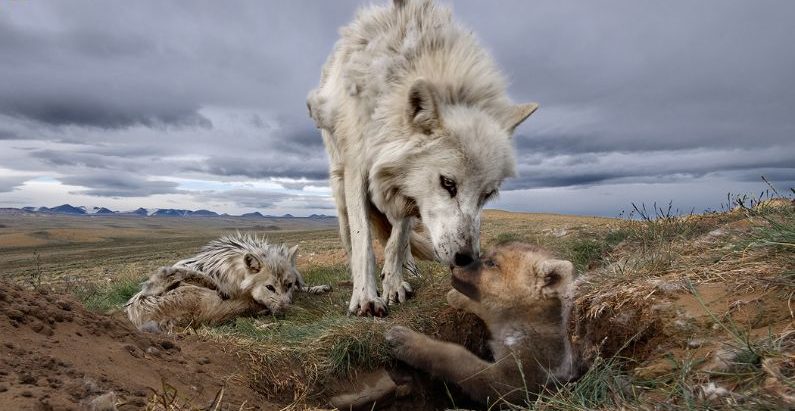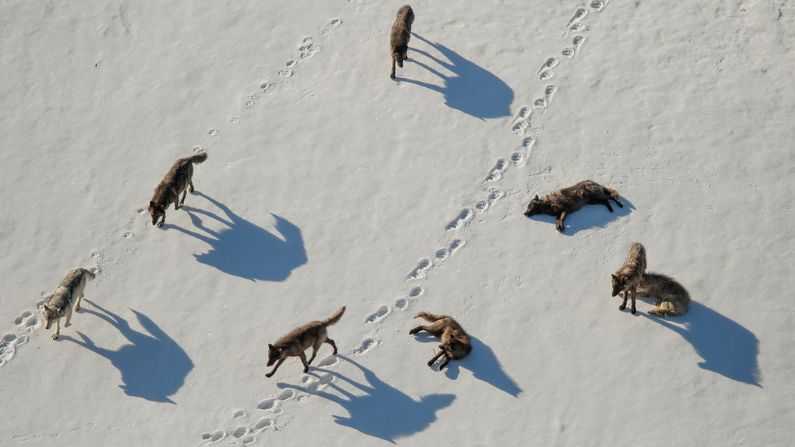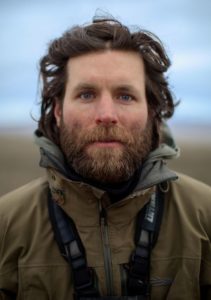Conservation photographer Ronan Donovan has lived much of the last eight years among wolves. As a National Geographic explorer, he’s witnessed different sides of the iconic canid’s personality everywhere from Yellowstone National Park to the high Canadian Arctic. Perhaps the most surprising one? Playfulness.
“I’ve woken up many times in my tent after working a long day to wolves plucking on the guylines of the tent just because it’s fun,” he recalled. “They’ve never come at me in a way that’s made me feel like I’m on the menu.”
Contrary to Donovan’s personal experiences, a culture of fear remains about wolves — especially in the West, where wolf-control laws have seen a recent resurgence. That’s why Jackson’s National Museum of Wildlife Art partnered with National Geographic to showcase Donovan’s images and videos of wild wolves. The exhibit shines a light on the complex relationship between wolves and humans, examining our shared history and persistent conflicts.
“When you start to unravel the myth and reality surrounding wolves and the curiosity people have, but also the fear or hatred or anger, you realize that wolves become this entry point to talk about wider issues surrounding the human relationship to wild animals,” Donovan said.
Donovan’s mission is to amplify science: He was a field researcher for eight years before transitioning full-time to photography. That’s when sharing science with a wider audience became more important to him, he said. Donovan’s obsession with wolves first began in 2014, when National Geographic gave him an assignment documenting the Yellowstone Wolf Project. From there, his passion for wolves took off.
Donovan soon traveled to Ellesmere Island in the Canadian Arctic. There, wolves rarely have negative encounters with humans or see them as threats. Donovan was able to document their daily lives — how they hunt, play and travel — because they weren’t fearful of humans. On the island, he experienced camaraderie between wolves and humans, just two hunters on the landscape, that existed for thousands of years before humans domesticated wolves.

A mother greets her six-week-old pup as a yearling female rests nearby on Ellesmere Island in Canada. (Ronan Donovan/National Geographic)
In Yellowstone, Donovan couldn’t access the same level of intimacy with the wolves, since they largely shy away from humans.
“People are scared of wolves,” he said. “The reality is that wolves are generally pretty scared of people.”
This is partly a result of wolf-control measures, such as the ones in Montana, Donovan said. In 2021, the Republican-controlled state legislature passed four wolf management bills which authorized reimbursements for wolf hunters and permitted formerly banned hunting methods, such as neck snares, among other aggressive measures. Last season, hunters killed 21 wolves near Yellowstone’s northern boundary.
According to Donovan, wolf management in Montana morphed from science-based to politically motivated. He said this is why it’s important to display an exhibit like his within the Greater Yellowstone Ecosystem.
“They’ll be images that [attendees] are familiar with from Yellowstone, and then there’ll be images that they are not familiar with from very far away in a place where humans and wolves don’t live in conflict,” Donovan said. “I feel it’s important for people to see and learn that contrast.”
The museum is presenting a “Wolf Weekend” from Friday, Nov. 4 to Sunday, Nov. 6 to kick off the exhibit. Events include:
- A sneak peak of the exhibit with Donovan on Nov. 4 from 11:30 a.m. to noon
- A community opening with waffles and wine on Nov. 4 from 5 to 7 p.m.
- A panel with experts on the human-wolf relationship on Nov. 6 from 10 to 11:30 a.m.
More information is available on the museum’s website.







